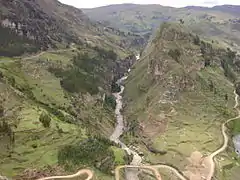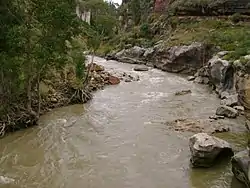Lawriqucha River
Lawriqucha River (Huánuco Quechua lawri bluish,[1] Quechua qucha lake, lagoon,[2] "bluish lake", hispanicized spelling Lauricocha) is a river in the Huánuco Region in Peru. It belongs to the watershed of the Marañón River. The river is named after the lake Lawriqucha or Lauricocha.
| Lawriqucha River | |
|---|---|
 The river Lawriqucha (center) just before its confluence with the Nupe River (on the right) | |
| Etymology | Quechua |
| Location | |
| Country | Peru |
| Region | Huánuco |
| Physical characteristics | |
| Mouth | Marañón River |
The Lawriqucha River originates in a small glacial lake in the Raura mountain range called Niñococha (10.458°S 76.764°W) at an elevation of 4,964 metres (16,286 ft). In 1952 this lake was identified as the source of the Amazon River by an English explorer, Sebastian Snow. Several other sources of the Amazon have been proposed. From Niñococha the river flows north through the Raura silver mine to Lake Lauricocha.[3][4] Near Lauricocha Lake is a stone bridge across the river dating back to the Inca Empire and still in use for horse and foot travel and the Lauricocha caves where archaeologists have found evidence of human habitation 10,000 years ago.[5][6] The river continues flowing north near the villages of Cauri (Kawri), Jesús and Jivia. Near the town of Rondos (Runtus) the Lawriqucha joins the Nupe River to form the Marañón. The elevation at the junction of the rivers is 3,318 metres (10,886 ft).[7]
The total length of the Lawriqucha River, in straight line distance from Niñococha Lake to its junction with the Nupe, is about 50 kilometres (31 mi).[8]

References
- Diccionario Quechua - Español - Quechua, Academía Mayor de la Lengua Quechua, Gobierno Regional Cusco, Cusco 2005: Lawri - s. Hist. (etim. De un dialecto huanuqueño: azulado). Cementerio inkaico en la provincia de Chankay, Lima, Perú.
- Teofilo Laime Ajacopa, Diccionario Bilingüe Iskay simipi yuyayk'ancha, La Paz, 2007 (Quechua-Spanish dictionary): qucha, qhucha, quchacha. - s. Laguna. Lago pequeño. qucha, qhucha. - s. Lago. Gran masa de agua en una depresión.
- "Sebastian Snow," (7 May 2001) The Telegraph, , accessed 6 Oct 2018
- Google Earth
- Enock, Reginald (1905), "The Ruins of 'Huanuco Viejo' or Old Huanuco, with Notes on an Expedition to the Upper Marañon," The Geographic Journal, Vol. 26, No. 2, page 162. Downloaded from JSTOR.
- Fehren-Schmitz; L, Llamas, B.; Lindauer, S.; et al (2015), "A Re-Appraisal of Early Andean Human Remains from Lauricocha in Peru," PLOS ONE, Vol. 10, No. 6, page 2. DOI:10.1371
- Google Earth
- Google Earth